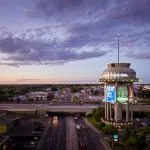
Hong Kong airport shuts down amid pro-democracy protest
HONG KONG — One of the world’s busiest airports cancelled all flights after thousands of Hong Kong pro-democracy protesters crowded into the main terminal Monday afternoon.
Hong Kong International Airport said in a statement that the demonstration “seriously disrupted” airport operations.
Hong Kong has experienced more than two months of mass protests calling for democratic reforms and an independent inquiry into police conduct, with both the protesters and police adopting ever-more extreme tactics.
In Beijing, the Cabinet’s Hong Kong and Macao Affairs Office issued a statement saying the situation in Hong Kong was “beginning to show the sprouts of terrorism” and constituted an “existential threat” to the population of Hong Kong.


